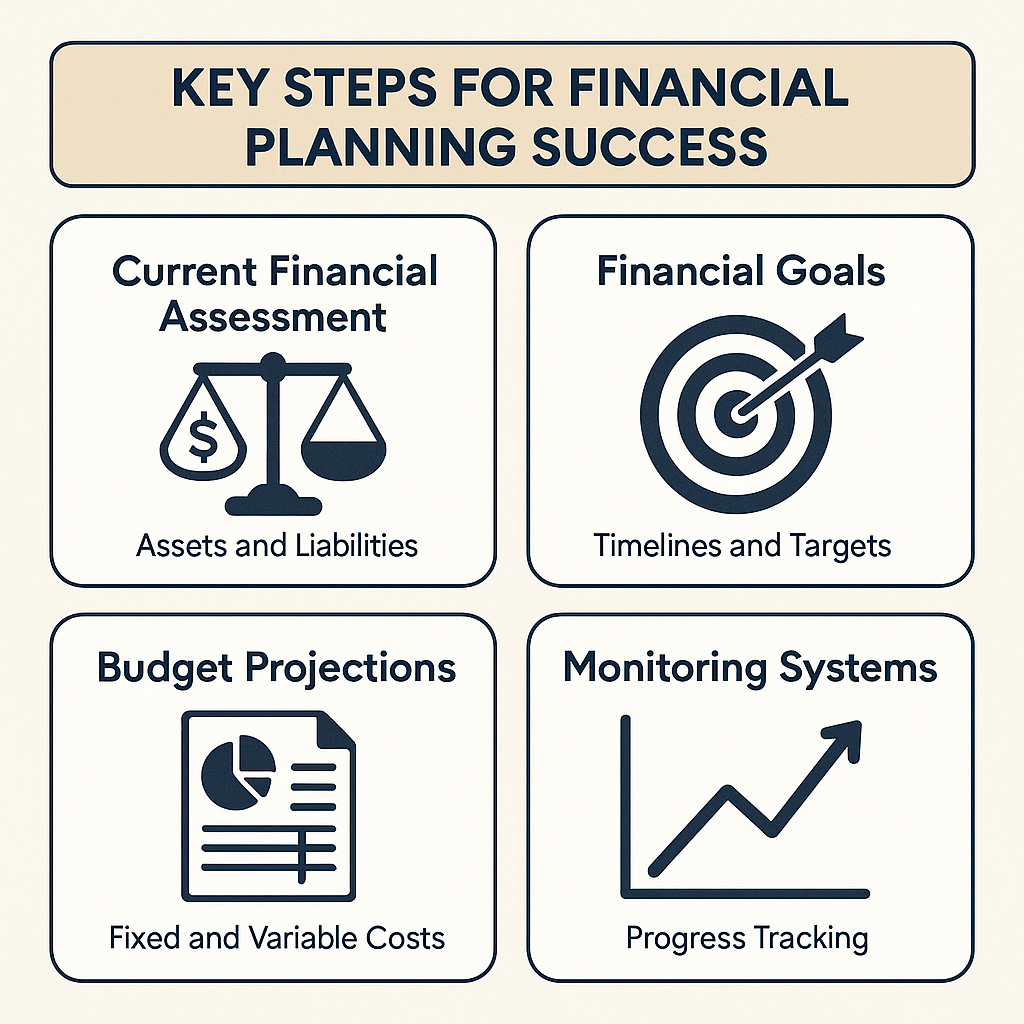Running a successful business requires more than just day-to-day operations. Smart entrepreneurs understand that long-term financial planning for funding success often determines whether their ventures thrive or merely survive. When you're seeking financing options, lenders and investors typically look beyond current revenue figures to evaluate your strategic planning capabilities and financial discipline.
Building a strong financial foundation involves several key components that work together to demonstrate your business's viability. From profit forecasting to reinvestment cycles, each element plays a crucial role in positioning your company for funding opportunities. Let's explore how you can develop a comprehensive approach to financial planning that may enhance your chances of securing the capital you need.
Common Questions About Long-Term Financial Planning
Understanding long-term financial planning for funding success often raises several important questions for business owners. These concerns typically center around practical implementation and expected outcomes.
Q: How far ahead should I plan my business finances?
Most financial experts suggest planning at least three to five years ahead for comprehensive funding preparation. This timeframe allows you to identify trends, establish realistic growth projections, and demonstrate sustainability to potential lenders or investors.
Q: What's the difference between cash flow planning and profit forecasting?
Cash flow planning tracks the timing of money moving in and out of your business, while profit forecasting focuses on projected earnings after expenses. Both are essential for funding success, but they serve different purposes in your overall financial strategy.
Q: How often should I update my financial projections?
Regular updates every quarter or when significant business changes occur help maintain accuracy. This ongoing process shows operational discipline and helps you adjust strategies as market conditions evolve.
Building Strong Profit Forecasting Systems
Effective profit forecasting forms the backbone of long-term financial planning for funding success. This process involves analyzing historical data, market trends, and business cycles to create realistic projections that lenders can trust.
- Analyze at least three years of historical financial data to identify seasonal patterns and growth trends that might influence future performance
- Factor in market conditions, competitive landscape changes, and economic indicators that could impact your industry sector
- Create conservative, moderate, and optimistic scenarios to demonstrate thorough planning and risk awareness to potential funding sources
- Include detailed assumptions behind each projection, showing the reasoning and research that supports your financial estimates
Your forecasting accuracy often improves with experience and regular refinement. Many successful businesses find that combining data-driven analysis with industry insights creates more reliable projections. This approach demonstrates the operational discipline that funding sources value when evaluating applications.
Managing Strategic Reinvestment Cycles
Smart reinvestment cycles can significantly strengthen your position when pursuing funding opportunities. This strategic approach involves timing capital investments to maximize growth potential while maintaining financial stability.
- Identify high-impact areas where reinvestment could generate measurable returns, such as equipment upgrades or staff training programs
- Time major investments to align with cash flow peaks and avoid periods when additional funding might be needed
- Document the expected ROI for each reinvestment decision to show lenders your strategic thinking and planning capabilities
- Balance growth investments with maintaining adequate cash reserves for operational stability and unexpected opportunities
Effective reinvestment cycles demonstrate your ability to think strategically about business growth. This long-term perspective often impresses funding sources because it shows you're not just focused on immediate needs but planning for sustainable expansion.
Developing Operational Discipline for Financial Success
Operational discipline in financial management could be one of the most important factors in achieving funding success. This involves creating systematic approaches to managing resources and maintaining consistent financial practices.
- Implement regular financial review processes that track performance against projections and identify variances early
- Establish clear spending authorization levels and approval processes to maintain budget control across all departments
- Create detailed record-keeping systems that provide transparent documentation of all financial transactions and decisions
- Develop contingency plans for various scenarios, showing lenders you're prepared for both challenges and opportunities
This disciplined approach to operations typically demonstrates to funding sources that you can manage capital responsibly. When lenders see systematic financial management practices, they may feel more confident about your ability to handle additional funding effectively.
Essential Steps for Comprehensive Financial Planning

Creating a comprehensive financial planning framework requires following specific steps that build upon each other. This systematic approach to long-term financial planning for funding success helps ensure you don't overlook critical elements.
- Conduct a thorough assessment of your current financial position, including assets, liabilities, cash flow patterns, and existing funding obligations
- Establish clear financial goals with specific timelines, measurable targets, and realistic milestones that align with your business growth objectives
- Develop detailed budget projections that account for both fixed costs and variable expenses, including seasonal fluctuations and growth-related increases
- Create monitoring systems that track progress against your financial plan and provide early warning signals for potential issues
- Build relationships with potential funding sources before you need capital, allowing time to demonstrate your planning capabilities and track record
This structured approach often yields better results than ad-hoc financial planning. Many businesses find that following these steps systematically creates a stronger foundation for funding applications and business growth initiatives.
Key Performance Indicators for Funding Readiness
Monitoring specific performance indicators can help you gauge your readiness for funding opportunities. These metrics often provide insight into areas that might need attention before approaching lenders or investors.
- Track your debt-to-income ratio and work to maintain levels that demonstrate strong financial management and repayment capacity
- Monitor cash flow consistency over multiple periods to show stability and predictable operations that reduce perceived risk
- Measure profitability trends and margins to demonstrate your ability to generate returns and sustain operations during various market conditions
- Evaluate working capital management efficiency, showing how effectively you manage inventory, receivables, and operational resources
Regular monitoring of these indicators might reveal trends that could impact funding decisions. By addressing potential concerns proactively, you may strengthen your position when funding opportunities arise. This proactive approach demonstrates the operational discipline that many funding sources value highly.
Long-term financial planning for funding success requires a comprehensive approach that combines strategic thinking with disciplined execution. By focusing on profit forecasting, managing reinvestment cycles effectively, and maintaining operational discipline, you create a foundation that could significantly enhance your funding prospects.
Remember that successful financial planning is an ongoing process, not a one-time activity. Regular reviews, updates, and adjustments help ensure your strategies remain relevant and effective as your business evolves. The time and effort invested in developing strong financial planning practices often pay dividends when funding opportunities arise.

.png)






